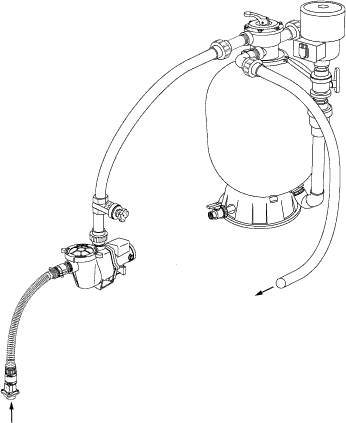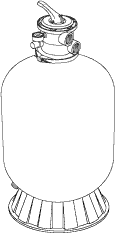 General Information
General InformationGreen Roofs
Rainwater Harvesting
Ponds and Wetlands
Systems
Liners
Filters
Pre-Filters
Gravel Filters
Waterfall Filters
Vortex Filters
Pressure Filters
Filter Media
Pumps
Plumbing
Fountains
Water Quality
Other Products
Documents
Energy-Efficient Building
Waterproofing

PRESSURE FILTERS
Pressure filters are sealed plastic tanks containing a filter media that provides mechanical filtration and supports bacterial colonies that provide biological filtration. They are built using the same tanks and control valves used for swimming pool filters, but have been completely re-engineered internally. Originally developed for the commercial aquaculture industry, this type of filter is ideal for koi ponds or any ponds with a significant fish population. We offer two versions with proven reliability. One uses a hollow plastic media that is very resistant to clogging but requires considerable water for backwashing; the other uses solid plastic media that clogs easier but includes an air blower that provides very effective backwashing with a minimum of water.
DESIGNING FOR PRESSURE FILTERS: Since pressure filters do not rely on gravity flow on either the inlet or outlet side, they have few design limitations. When used with submersible pumps, water can be pumped over the pond edge or through the side of the pond to the filter. The filter can be located either above or below the water surface and can be a considerable distance away. With external pumps, water can be drawn over the pond edge, through the side of the pond, or through the bottom of the pond. When water is drawn over the pond edge, the pump must be located above the water surface and the suction line cannot dip before reaching the pump inlet. When water is drawn through the side of the pond or through the bottom of the pond the filter can be located either above or below the water surface and dips in the line are only a problem when they occur above the water surface. The distance between the pond and the pump should be kept as small as possible, but long suction lines are possible with proper pipe sizing.
When filled with water, pressure filters are very heavy and require a strong, level base. When pressure filters are installed in pits, outbuildings, and other confined spaces, the clear ceiling height of the space must be at least twice the height of the tank so the control valve and internal plumbing can be removed. We provide unions for each of the pipe connections to facilitate disassembly of the tank for annual cleaning. During the backwash and rinse cycles, waste will flow through the backwash port which needs to be plumbed to an ornamental plant garden or other suitable site.
Effective prefiltration will significantly reduce maintenance requirements for pressure filters. The ideal technique for heavy solids loads is to use an external pump to draw from a vortex prefilter that is gravity fed from a bottom drain (see A KOI POND), but this is the most difficult to install. More typically, the external pump draws through a slotted pipe intake assembly.
HOLLOW MEDIA PRESSURE FILTERS: Hollow media pressure filters contain millions of small ribbed plastic tubes that float in the upper half of the tank. Water enters and exits the filter through a sophisticated yet easy-to-use multi-port valve with filter, backwash, and rinse settings. With the valve set to filter, the water flows out of slots at the bottom of the tank, passes through the floating plastic media where it is mechanically strained and biologically filtered, and flows out through slots at the top. During backwash, internal jets generate a cyclonic action that blasts the media apart, then lifts and spins it, separating the waste and flushing it away.
hollow-media |
pressure filter with intake |
We offer eight hollow-media pressure filters for ponds up to 60,000 gallons; for larger ponds, several filters can be ganged together. The following chart shows specifications for each:
| Characteristics of Hollow-Media Pressure Filters | |||||||
| pond | fish | flow | ports | pump | waste | media | size |
| 1000 gal | 100 lbs | 1000 gph | 1.5" | EP12 | 50 gal | 5 lbs | 15"x27" |
| 2000 gal | 200 lbs | 2000 gph | 1.5" | EP12 | 100 gal | 10 lbs | 17"x36" |
| 4000 gal | 400 lbs | 4000 gph | 1.5", 2" | EP25 | 150 gal | 24 lbs | 21"x41" |
| 6000 gal | 650 lbs | 6000 gph | 2" | EP33 | 200 gal | 36 lbs | 22"x44" |
| 10000 gal | 1300 lbs | 7500 gph | 2" | EP50 | 300 gal | 48 lbs | 25"x46" |
| 20000 gal | 2000 lbs | 7500 gph | 2" | EP75 | 450 gal | 84 lbs | 31"x50" |
| 30000 gal | 3000 lbs | 7500 gph | 2" | EP100 | 600 gal | 120 lbs | 40"x49" |
| 30000 gal | 3000 lbs | 15000 gph | 3" | EP150 | 600 gal | 60 lbs | 40"x49" |
| 60000 gal | 6000 lbs | 15000 gph | 3" | EP150 | 750 gal | 100 lbs | 54"x46" |
Routine maintenance takes about fifteen minutes each week. First, the pump is turned off and the control valve is rotated to the backwash position. Next, the pump is run for thirty to sixty seconds to carry the accumulated organic matter flows through the waste outlet for disposal. When the sight glass is clear, the pump is turned off, the control valve is rotated to the rinse position, and the pump is run again for a few seconds until the sight glass is again clear. This backwash/rinse sequence is repeated three times. Finally, the valve is returned to the filter position and normal operation resumes.
SOLID MEDIA PRESSURE FILTERS: Solid media pressure filters, often called bead filters, contain millions of 1/8" diameter solid plastic spheres that float in the upper half of the tank. Water enters and exits the filter through a sophisticated yet easy-to-use multi-port valve with filter, backwash, and rinse settings. In the Aquadyne bead filter we offer, the water then passes through the patented low-friction central diffuser column that virtually eliminates the frequent clogging associated with other bead systems on the market. With the valve set to filter, the water flows out of slots at the bottom of the diffuser column, passes through the floating plastic media where it is mechanically strained and biologically filtered, and flows out through slots at the top of the diffuser.

solid-media pressure filter with pump and backwash blower
Routine maintenance takes about fifteen minutes, once each week. First, the pump is turned off, the control valve is rotated to the rinse position, and the air blower is operated for a few minutes to break up the beads and dislodge organic matter. Next, the control valve is rotated to the backwash position and the pump is turned on to carry accumulated organic matter through the waste line for disposal. When the sight glass is clear, the pump is turned off, the control valve is rotated to the rinse position, and the pump is turned on again. After the sight glass is again clear, the valve is returned to the filter position and the sludge valve is opened for a few seconds to purge sludge that accumlates at the bottom of the tank.
We offer four solid-media pressure filters for ponds up to 28,000 gallons; for larger ponds, several filters can be ganged together. The following chart shows specifications for each filter. All are supplied with air blowers to permit backwashing with low-pressure energy-efficient pumps: note the dramatically lower waste water volume when compared with hollow media filters without air blowers.
| Characteristics of Solid-Media Pressure Filters | |||||||
pond |
fish | flow | ports | pump | waste | media | size |
| 3500 gal | 65 lbs | 3000 gal | 1.5" | EP12 | 30 gal | 40 lbs | 18"x38" |
| 7500 gal | 150 lbs | 4000 gal | 1.5", 2" | EP25 | 50 gal | 80 lbs | 24"x46" |
| 14000 gal | 300 lbs | 6000 gal | 2" | EP33 | 60 gal | 160 lbs | 30"x46" |
| 28000 gal | 480 lbs | 6000 gal | 2" | EP33 | 80 gal | 320 lbs | 36"x48" |
PRICING: Call or email for current pricing.

